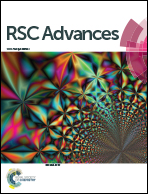Surface flattening of a polyimide layer in a liquid crystal cell fabricated by using a field-induced UV-alignment method
Abstract
We previously published a liquid crystal alignment method using an ultraviolet (UV)-curable polymer for the near-zero pretilt angle. We have shown that the pretilt angle can be lowered by curing a reactive mesogen in the alignment layer while applying a vertical electric field. In this study, we analyzed the mechanism behind these observations. Using X-ray photoelectron spectroscopy, we confirmed that the C 1s and O 1s peaks show neither a wavelength shift nor an intensity change by UV curing, regardless of application of an electric field. We also confirmed the characteristics of the flattened surface after UV curing under an applied electric field, using atomic force microscopy. We found by atomic force microscopy that the decrease in pretilt angle is related to the flattened surface in a homogeneously aligned LC cell fabricated with the field-induced UV-alignment method.



 Please wait while we load your content...
Please wait while we load your content...